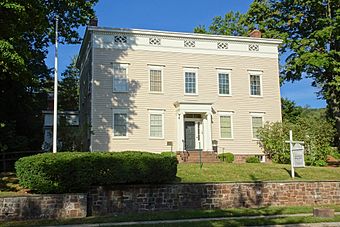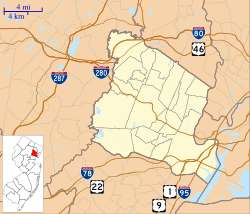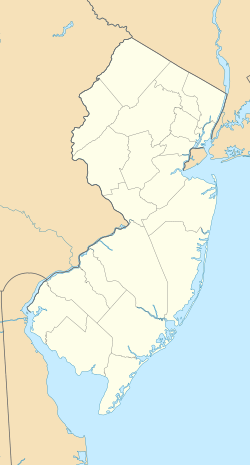Crane House and Historic YWCA facts for kids
|
Crane House and Historic YWCA
|
|

Crane House and Historic YWCA in 2016
|
|
| Location | 110 Orange Road Montclair, New Jersey |
|---|---|
| Area | 1.1 acres (0.45 ha) |
| Built | 1796 |
| NRHP reference No. | 73001091 |
Quick facts for kids Significant dates |
|
| Added to NRHP | March 14, 1973 |
The Crane House and Historic YWCA is a beautiful old home in Montclair, New Jersey. It was built in a classic style and has a very interesting past. This house was added to the National Register of Historic Places on March 14, 1973. It is important because of its architecture, its history of being saved, and its connection to local businesses.
Contents
A Look Back at the Crane House
How the House Began
The Crane House was built by a man named Israel Crane in 1796. It was first located on Old Road, which is now Glen Ridge Avenue. This area was once called Cranetown, named after Israel Crane's family. The house stayed with the Crane family for a long time, until 1920.
The YWCA's New Home
In 1920, the YWCA (Young Women's Christian Association) bought the house. The YWCA used the house for many years, until 1965. It served as offices, a place for women to live, and a social spot for African American women and girls.
Saving the Crane House
By 1965, the house was in danger of being torn down. But local people who cared about history stepped in to save it! They organized a plan to move the entire house. It was carefully moved from Old Road to its current address at 110 Orange Road.
Today, the Crane House and Historic YWCA is one of the few old mansions left in northern New Jersey. It is now open to the public for tours. It stands next to two other historic buildings: the Clark House and the Nathaniel Crane House. All these buildings are owned by the Montclair History Center.
Israel Crane and His Business Ideas
The Crane Family's Roots
Israel Crane was born in 1774. He came from the Crane family, who first settled Cranetown in 1694. Israel was a smart and active businessman. He was successful in several industries, like making cider and producing cotton and wool.
In 1801, he and a partner rented a spot in Paterson, New Jersey. They used the power of the Passaic River for one of the very first mills there.
Building Important Roads
In 1806, Crane helped create a group to build the Newark-Pompton Turnpike. This was a special toll road for businesses. He later became the only owner of this road. It was a direct path from Newark, New Jersey to other areas, including Cranetown.
Today, parts of this old road are still used. Bloomfield Avenue, which goes through Montclair, is one part. Another section became Route 23, which reaches all the way to Port Jervis.
Life at the Crane House
The Israel Crane house has seen many generations of history. When Israel Crane built it in 1796, it showed what a wealthy home in the Montclair area (then Cranetown) looked like. Records show that Israel Crane had several enslaved individuals living there.
Later, his son, James Crane, took over the house. By this time, society had changed. Records show that James Crane did not have enslaved individuals. Instead, he hired people to work for him, often Irish immigrants. James also made changes to the house, adding Greek Revival style elements. These included columns in the front and a flat roof. James Crane passed away in 1882.
In 1900, James Crane's wife, Phebe Crane, lived in the house with her three unmarried daughters. After Phebe died in 1902, her daughters sold the house.
Visiting the Crane House and Historic YWCA
The Crane House and Museum welcomes visitors for tours. You can explore the house with a guide or on your own on certain days.
The YWCA's Important Work
After a few different owners, the old Crane House was bought by the YWCA (Young Women's Christian Association) in 1920. The YWCA in Montclair started in 1912. It was founded by 19 women from the Black community, including Alice Hooe Foster. She was the first Black woman to graduate from Montclair High School.
At a time when many opportunities were limited for Black women and girls, the YWCA offered a way to help them. It provided skills, safe social experiences, and chances for better jobs and education. The Israel Crane house became a place where African-American women could stay in Montclair. They could look for domestic jobs or connect with others in their community. The rooms were used as dormitories and offices.
By 1965, the women of the YWCA sold the building to build a new headquarters. A condition of the sale was that the old house had to be moved to make space for the new building.
Even though Montclair schools were no longer segregated, other parts of life, like clubs and dances, still were. The women of the YWCA kept working to make it a place where they could truly grow. The organization continued until 1990. The YWCA was officially closed in 2001 because fewer people were participating, and it became too expensive to keep the building. However, the board still wanted to support women. They put their funds into what is now the Montclair Fund for Women. In 2014, the Montclair History Center made a documentary called “A Place to Become.” It tells the story of the YWCA and its local members. You can watch it on their YouTube page.
What You Can See at the Crane House
Inside the Historic Rooms
The Crane House and Historic YWCA has ten rooms. These rooms show furniture, paintings, and decorative items from the 1700s, 1800s, and 1900s. You can see rugs, quilts, ceramics, glassware, silverware, toys, dolls, and everyday household items. There are also copies of YWCA materials.
Some special items on display include a painted bedroom set from 1816. It once belonged to Paul Revere IV. You can also see a harp made in 1827 by Sebastian Erard, and a tall chest of drawers called a highboy from 1740.
Restoring the House's History
The people who saved the house bought it before it could be torn down. They had the building moved to its current spot at 110 Orange Road. These early preservationists formed the Montclair Historical Society. They worked hard to make the building look like it did when Israel and James Crane lived there.
Until 2014, the house mainly focused on its early American history. Now, the Montclair History Center tells the complete story of the house. This includes its time as the YWCA, covering its use from 1796 to 1965.
See also




